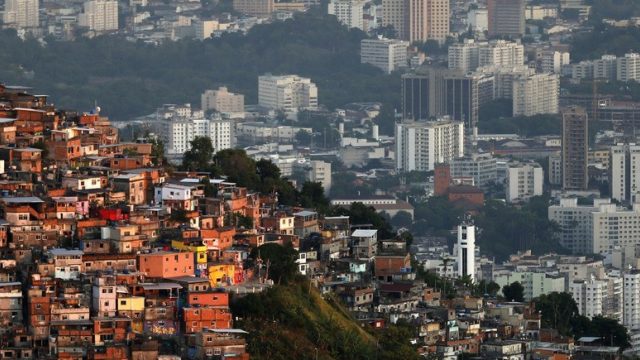Can we protect the rights of nature in a green economy?

If we put prices on all of our ecosystems we may risk moving even further down the wrong development pathway - whereby everything is seen in economic terms.
Reports of environmental problems or biodiversity loss are not new. Since the 60s, there has been an increasing amount of information about the environmental impacts of conventional development strategies based on economic growth. The present environmental crisis indicates that those alerts have been ignored.
Green Economy, as initiated by the United Nations Environmental Program (UNEP), is one of the most recent ‘new’ approaches to development. UNEP defines the Green Economy as one that results in ’improved human well-being and social equity, while significantly reducing environmental risks and ecological scarcities’ (UNEP 2010). The idea is said to be a reaction to several factors, especially to current economic thinking, and promotes the Green Economy as a new economic paradigm towards a new economy that will be low-carbon, resource efficient and social inclusive, while also protecting biodiversity.
There is a heated controversy around the notion and unanswered questions surrounding a Green Economy approach. As a contribution to these discussions, we would like to focus in a specific role of the green economy: its possibilities and limitations in biodiversity conservation. In particularly we would like to explore these issues in light of the Green Economy approach and present proposals of Nature’s rights in South America.
Green Economy is not so 'green'
Regarding Nature, the main proposition of the Green Economy is that it will significantly reduce environmental risks and impacts by promoting the efficient and sustainable use of natural resources. Many of the specific tools to achieve that goal derive from environmental economics, which considers Nature as fragmented and divided into “natural resources” or environmental “goods” or “services”; Nature is seen as another form of capital: “Natural Capital”. The services that Nature provides may have an economic value and in some cases, may be related to human property rights.
There are several problems with this understanding of Nature; among them, a tendency to confuse economic value with the “real” value of Nature. This is also the central aim of neo-liberal market-based conservation, which relies on the assumption that biodiversity’s non-monetarised values are deemed insufficient to preserve it (Ervine 2011). Furthermore, the Green Economy approach considers that valuing natural capital in economic terms is the way to indicate its importance for sustaining human and economic prosperity (UNEP 2011). Thus, the conservation of Nature will only be ensured if we are able to incorporate it into profitable economic processes, in which Nature becomes another Capital.
Green Economy is heavily dependent on a market-based economic approach. The most cited environmental economic tool is the use of Payment for Ecosystem Services (PES), which is defined as a voluntary transaction of an ecosystem service (ES) among a buyer and a seller of the ES, which must secure the ES provision. The schemes are presented as new conservation paradigms. However, there is still a lack of good evidence confirming PES effects on conservation and where evidence has been found, the effects are only local. Furthermore, PES contracts are always time limited despite the fact that conservation needs a much longer time-frame. The success of the conservation project depends on the willingness of a buyer to pay again for the ES – turning conservation into a cost-benefit decision.
Beyond prices: Nature’s intrinsic values
A different approach is possible. It departs from the utilitarian perspective and instead recognizes the multiple values of Nature, including ecological, cultural, religious, aesthetics, etc. After-all, economic value is just one dimension amongst many; and price is only one indicator amongst many. In our opinion, nature cannot be measured or valued with only one criterion; rather the valuation should be multidimensional. This approach is not new and has been explored by ecological economists as well as environmentalists.
Once we have accepted the need for alternative values, the next step is to understand the intrinsic value of Nature. Intrinsic value is not human-centric and exists in the absence of humans; for example, the life processes found in tropical forests would continue irrespective of human life. This approach understands that animals and plants have their own right to exist, and that they do not need to be deemed useful or beautiful by humans in order to be granted protection. Recognizing the intrinsic value of Nature will also lead the way for recognizing the formal, legal rights of Nature, which is a critical part of protecting our natural heritage.
The failure of the Green Economy approach to recognize an ethical perspective is a major problem, not only because it fails to protect the intrinsic values which are such a part of Nature conservation, but also because it fails to understand the cultural, policy and politics implications.
From a cultural point-of-view, many non-western knowledge and belief systems recognize the intrinsic values of Nature; particularly indigenous peoples who also live in threatened ecosystems. The absence of the cultural perspective seriously undermines the credibility of the Green Economy as a viable approach. From a political perspective, the movement to recognize the rights of Nature is already underway. Ecuador is the first country to have recognized Nature’s rights in its new constitution, along with the classical human-centered view of the rights for a good quality of life and environmental conservation (see discussion in Gudynas, 2009). These two aspects, the cultural one and the political shifts, are needed and should be included in any initiative for a global change.
Lastly, there is a policy dimension, which is also critical. If we adopt a Nature’s rights approach then, local communities, in particular, or citizens in general, would not need evidence or policies to prove the links between environmental damage and economic performance, or the potential usefulness of a particular species or ecosystem service. On the contrary, species and ecosystems would be conserved on the basis of their intrinsic value.
“ In a Green Economy approach, we must prove the benefits that ecosystem-services provide us in order to prevent ecological scarcities and environmental risks. By contrast, recognizing the rights of Nature at the global level would mean that there is no need to demonstrate the economic value of Nature or ecosystems; Nature’s value is implicit in its concept.”
The Green Economy takes an anthropocentric perspective, which is also the case for traditional western view of development and progress. This anthropocentric perspective not only centers on humans, but also implies that humans are separate from Nature; in short, Nature is just a basket of resources that humans must take advantage of to feed economic growth (Gudynas 2011; 262). By comparison, by adopting the intrinsic value perspective, we acknowledge that Nature has its own place within human societies, like humans will have its place within Nature’s organization. Humans and Nature are not separated.
It is important to note that, as Stone (1972) has stated, recognizing the rights of Nature does not mean that it would be afforded every right that we can imagine or even the same body of rights that humans have. Neither does it mean that all species are equal and have the same rights, and that humans are equal to an ant (Gudynas 2011; 270). Rather, it means that every species has the right to exist and to self-realization (Devall and Sessions 1985).
In our alternative scenario in which we understand both the intrinsic and multi-dimensional values of Nature, we would have conservation policies that, without neglecting human needs, would be Nature-oriented - ensuring a Nature base for future generations - but also for other forms of living, not only humans. We would be obligated to protect at least some proportion of all the ecosystems and ecological regions in order to ensure that biological communities can evolve. We would also be required to restore degraded eco-regions and to organize our productive lands and the way in we produce our food.
In a Green Economy scenario recognizing Nature’s rights seems odd, since it is inconsistent with its ultimate goal: economic growth. In our alternative scenario, with Nature’s rights recognized and a multiple valuation of Nature (not only economic), we would consider Nature as Patrimony, not as a basket of resources. We would shift our thinking to a bio-centric perspective, recognizing that we have limitations imposed by biosphere that are absolute.
The ethical dimension and the rights of Nature are crucial issues to discuss at Rio+20. However, we should be aware that these issues going to rock hard the concept of a Green Economy, because they go to the very roots of our problems because ultimately it addresses our notions of development and the role that Nature may play within it.
How can we put this in practice?
In a Green Economy approach, we must prove the benefits that ecosystem-services provide us in order to prevent ecological scarcities and environmental risks. By contrast, recognizing the rights of Nature at the global level would mean that there is no need to demonstrate the economic value of Nature or ecosystems; Nature’s value is implicit in its concept. This would open the discussion to other visions of Nature and other interpretations of development.
We recognize the extent of economic pressures on our ecosystems today. To ensure that we do not go further down the wrong path, either via a Green Economy approach or otherwise, we propose the following practical steps: We should demand the strict conservation and protection of at least the 10% of the world’s eco-regions; we should then add a further 25% of natural areas which allow for some kind of human intervention; and finally, we should turn towards 100% organic modes of production.
Finally, for the appropriate implementation of this biocentric perspective we should change our view of conceiving Nature. We should re-educate our children to teach them that Nature is not a thing that we can use and abuse. Nature should have its guardians -as Stone (1972) called Nature’s defendants- and its own representatives within global conversations, forums and meetings, such as the Rio+20 summit. We should add a new stakeholder: Nature.
Soledad Ghione & Eduardo Gudynas, Latin American Center for Social Ecology
References
Devall, B. and Sessions, G. 1985. Deep Ecology: Living as if Nature Mattered. Salt Lake City: Smith.
Ervine, K. 2011. Conservation and conflict: the intensification of property rights disputes under market-based conservation in Chiapas, México. Journal of Political Ecology, 18: 66-80.
Gudynas, E. 2009. La ecología política del giro biocéntrico en la nueva Constitución de Ecuador. Revista Estudios Sociales, 32: 34-47. Colombia.
Gudynas, E. 2011. Los derechos de la Naturaleza en serio. In: La Naturaleza con derechos. De la filosofía a la práctica. A. Acosta y E. Martínez, Eds., pp. 239-286. Quito, Ecuador.
Stone, C.D. 1972. Should Trees Have Standing? Toward Legal Rights for Natural Objects. Oxford University Press, pp. 264.
UNEP, 2010. Towards a Green Economy: Pathways to Sustainable Development and Poverty Eradication. UNEP, pp. 631 (http://www.unep.org/greeneconomy/greeneconomyreport/tabid/29846/default....)
UNEP 2011. Valuing Nature. Briefing papers, UNEP, pp.4 (http://www.unep.ch/etb/publications/GE%20Briefs%202012/reprint%20GE_VALU...)
Wunder, S. 2005. Payments for environmental services: some nuts and bolts. Center for International Forest Research, Occasional Paper No. 42, pp. 32.
Soledad Ghione and Eduardo Gudynas are researchers on the Latin American Center for Social Ecology: Magallanes 1334, Montevideo, Uruguay.
Email: s.ghione@ambiental.net, egudynas@ambiental.net
Web-pages:
www.ambiental.net
www.derechosdelanaturaleza.com
www.transiciones.org
www.ecologiayconservacion.com


